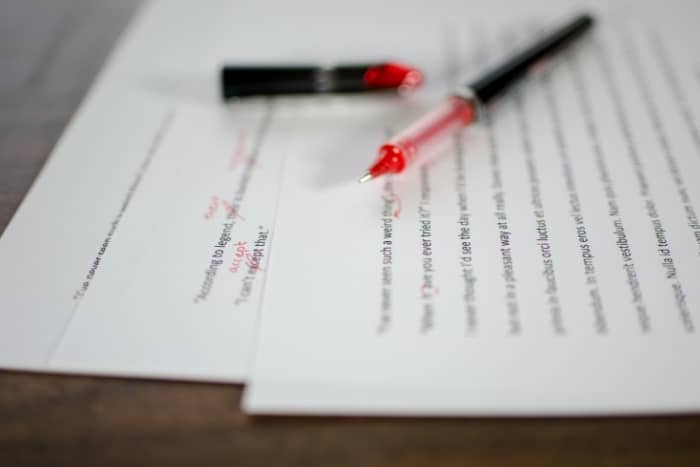Following a writing process will make your life much easier.
Do you ever find yourself scrapping something you’ve written because it’s not coming together?
Maybe you don’t even get that far. You write a paragraph or two, run out of steam, and just can’t figure out where to go next.
This is why intentionally following the writing process — a sequence of steps every piece of writing needs to go through — is so important. It’s the same process for bloggers, copywriters, novelists, and even students working on writing assignments or research papers.
We’re going to explain what those steps are and give you some tips for nailing each one so you end up with a fantastic finished piece.
And if you’re short on time?
Then the writing process helps you make the most of it.

The 6 Steps of the Writing Process
The writing process follows six key steps:
- Prewriting
- Planning
- Drafting
- Revising
- Editing & proofreading
- Publishing
Each step is important.
If you’re writing something short, like a blog post, some of the steps may take just a few minutes. If you’re working on a major project, like self-publishing an ebook, then some of them may take weeks or months.
The six steps are the same, whatever you’re writing, and however long (or short) it is. We’re going to explain each one and cover some frequently asked questions.
Ready?
Let’s get started.
1. Prewriting

Prewriting is what you do before you start writing.
Without prewriting, you can’t make a plan because you don’t know what you’re going to write about.
Prewriting means:
- Coming up with an idea or topic for your blog post, ebook, novel, landing page, essay, paper, or whatever you’re going to write. You could use brainstorming to come up with several different ideas before settling on one. (For freelance writing jobs, you may have already been given the title or topic to write about.)
- Researching your idea. If you’re writing about a very familiar topic, you might have done plenty of research in the past. Often, though, you’ll need to explore further. At this stage, you might be making notes, saving useful links, gathering material for a case study, or jotting down the names of people you want to interview about your topic. You might also spend time thinking about your intended audience.
2. Planning

Once you have an idea and you’ve done some research, it’s time to plan your project.
There are lots of different ways you can plan.
You don’t necessarily need to create a step-by-step outline. Many writers find it helpful to use a visual format, like a mind map. Some writers plan on index cards, moving them around: this is a great approach for longer projects. Others use freewriting to start exploring their idea in a creative way.
Aim to start your planning by generating possibilities-without worrying if they’re “right” or not. Come up with more than you need.
For instance, you might list 15 possible points for a 10-point list post. Then, you can select the best ones, before getting them into the right order. These points will often become the headings or subheadings in your finished piece.
3. Drafting

This is the stage that most people think of as “writing,” but it’s really only one part of the writing process.
Drafting your piece can feel daunting. It’s a step that many writers procrastinate over.
If you’ve done your prewriting and planning, though, you should feel a lot more confident about moving forward with your draft.
Your first draft is never going to be perfect. You’ll likely have some unnecessary paragraphs, some clunky sentences, and probably a few typos or grammatical slips.
None of that matters at this stage. Your goal when drafting is simply to keep moving forward.
4. Revising

Revising literally means “seeing again.”
This stage is also sometimes called rewriting. It’s when you come to your work with fresh eyes and look at the big picture to see what needs to change.
You might cut out the first two paragraphs of your blog post if the introduction drags on too long. You might also swap subsections around, merge two short sections together, or take out some material to use in a different post.
If you’re an experienced blogger or freelance writer, and you’ve written a solid plan, this might be a short step — but it shouldn’t be non-existent. You should at least read through your work with an eye for potential big-picture changes, even if you end up deciding that you’re happy with your piece as-is.
5. Editing and Proofreading

After making any big-picture changes to your piece, it’s time to dig into the details and fine-tune your work.
This means reading through carefully and looking out for things like:
- Poor sentence structure that could confuse or trip up the reader
- Awkward phrasings that don’t sound quite right
- Words or phrases that are used too frequently
- Grammatical mistakes (such as incorrect subject/verb agreement)
- Spelling mistakes (such as using “there” when you mean “their”)
- Typos (such as typing “teh” when you mean “the”)
- Punctuation mistakes (such as inconsistent capitalization or a misplaced comma)
- Consistency with a style guide, such as APA style
- Correct attribution of quotes
If you’re working on a long piece, it’s a good idea to separate the editing process from proofreading. Once you get to the proofreading stage, you should just be looking out for small mistakes, rather than making stylistic changes or deliberating on your exact word choice.
Make sure you run your post through a good grammar checker, too, just in case you missed something.
6. Publishing

Your work isn’t complete until it’s published.
At this stage of the writing process, you might be formatting your post in WordPress and publishing your work on your blog. This may involve things like creating a meta description, adding in links, and creating a featured image.
Alternatively, you might submit the piece to a client, editor, or publication.
If they want changes, you may need to circle back to the “revision” and “editing and proofreading” steps.
Frequently Asked Questions About the Writing Process
What’s the Most Important Step in the Writing Process?
All the steps of the writing process are important.
You might think that drafting matters the most because, without it, you can’t have anything that looks like a finished piece. However, the prewriting stage is hugely significant: coming up and developing a strong idea will make every other stage easier.
Ultimately, all the steps matter, but prewriting (step 1) and drafting (step 3) are especially crucial steps to focus on.
Can I Skip Steps in the Writing Process?
It’s not advised!
Also, most writers find themselves following these steps whether or not they realize it. For instance, they might brainstorm ideas in the shower, ruminate on a particular idea, have a loose plan in mind, then sit down to draft.
However, the first two steps of the writing process may not have been executed well—and the writer may need to go back and replan after writing a very rough draft-but they have taken place.
Some writers skip revising (step 4) and editing (step 5), instead opting to publish their first draft. This means their piece won’t be as strong as it should be.
Even excellent writers still need to do some editing.
If you’re struggling with writer’s block, that may be because you’ve not completed the earlier steps in the process.
Trying to draft without going through the prewriting stage or planning stage is often going to leave you feeling stuck. You simply haven’t had the time to think through and organize your ideas.
What’s the Hardest Step in the Writing Process?
There’s no one step of the writing process that’s intrinsically harder than the others.
Some writers find drafting really hard, while others struggle with coming up with ideas. Some hate proofreading and prefer to outsource it.
If you are finding a particular step of the process hard, look for ways to change how you approach it.
For instance, if you always struggle to plan, you might look at different planning techniques-like mind mapping, using a template structure for your work, talking through your ideas and recording what you say, or even drawing a storyboard for your piece.
Improve Your Writing Process Today
Maybe you’ve never thought about the writing process from start to end before.
Or perhaps there’s a particular step you struggle with.
You don’t need to master every step at once.
Pick one step of the writing process to focus on today. Spend 20 minutes on that step alone, and see what a difference it makes to your finished piece.
Good luck!



